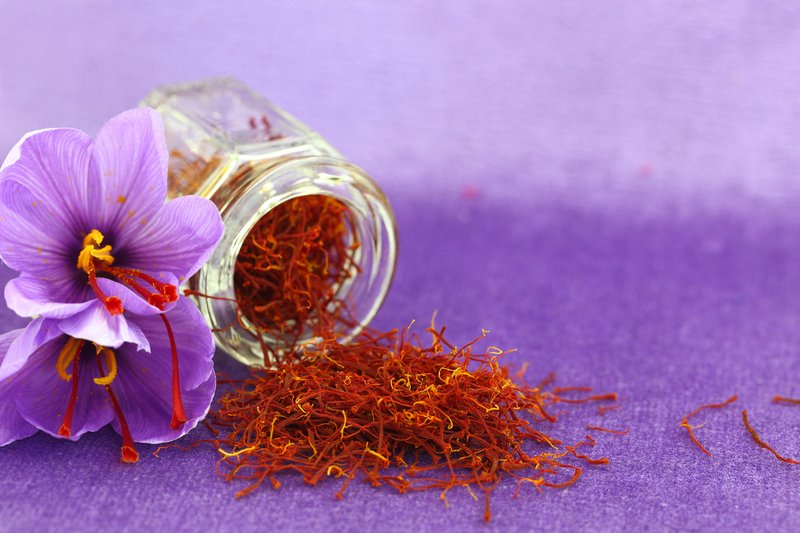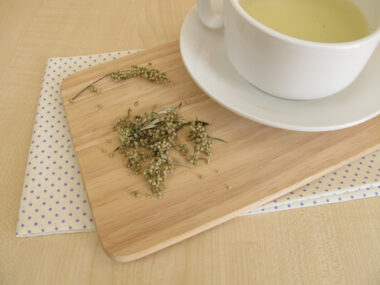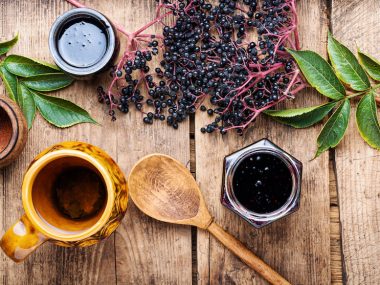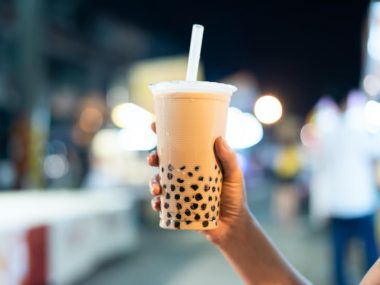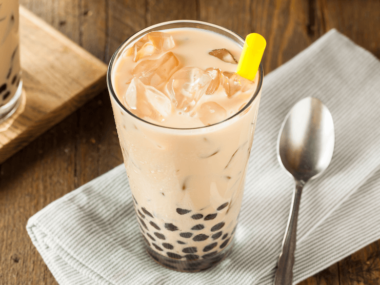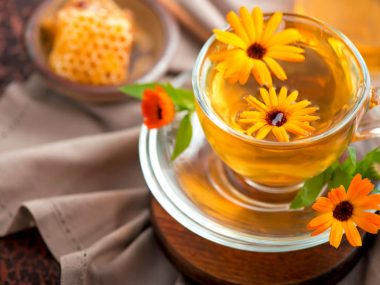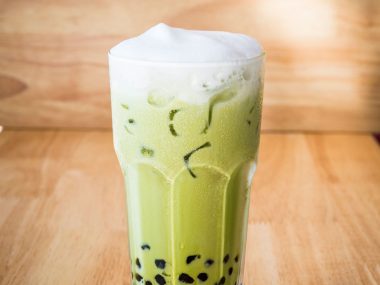When it comes to exotic and expensive, this tea is the one that fits the bill. Half a teaspoon of saffron can easily eat up a $5 bill.
Table of Contents
What Is Saffron?
Saffron is a spice harvested from Crocus sativus (a purple crocus flower.) In the center of the cup-like flower are protruding vibrant orange stigmas. These orange stigmas are the part of the flower that saffron comes from.
The saffron crocus is primarily cultivated in Mediterranean countries such as Spain, Italy, Greece, Iran, India, Southern Asia, and countries in between. The majority of the world’s saffron supply comes from Iran and Spain.
The Laboratory of Biology of Plants and Microorganisms in Morocco published an article that included some interesting data on saffron. It mentioned that the use of saffron was discovered in a fresco dating as far back as the mid-1700s BC during the Middle Minoan II period. An excavation at Knossos, Crete unearthed the fresco, which depicted subjects gathering saffron.
Saffron’s High Dollar Value
Saffron is the most expensive spice because of how labor-intensive harvesting it is and the number of flowers it takes to produce a mere handful of it. To give you a perspective on how costly it is, it takes 150,000 flowers to make 1 kg of saffron. For the amount you pay for one kilogram of saffron ($34,143.00 USD – $30,000 Euro,) you could instead purchase a tiny house or a car.
Beware Of Fake Saffron
Because of the high dollar value of authentic saffron, fake saffron is rampantly marketed by dishonest sellers. To gain any benefit from saffron tea, authentic saffron should be sourced for the tea. Otherwise, tea drinkers unknowingly drink a tea disguised as saffron (or containing saffron.)
Genuine loose saffron should be trumpet-shaped, be slow to turn yellow in the water, and have a bitter/astringent taste (never sweet.) Powdered saffron is a bit more challenging to distinguish fake or genuine. The counterfeit saffron powder may be artificially colored or ramped up with turmeric or paprika.
Harvesting And Processing Of Saffron
The saffron crocus (unlike most other flower species) blooms in the fall during a two-week period. During this time, harvesters must pluck the flowers by hand and take them back to undergo further processing. The stigmas must be separated from the flowers manually.
The plucked stigmas are then gently dried and packaged in airtight containers. Should a saffron processor use clear containers or ones that are not airtight, the saffron quickly degrades. It is susceptible to air and light.
Teas Made With Saffron
There are numerous different teas that contain saffron. Of course, the most common saffron tea is the tisane (herbal tea) which is an unadulterated saffron tea (no other ingredients.) It’s not unusual to find green and Ceylon teas infused with saffron to add an extra layer of flavor. Tisanes with saffron include rooibos, chai, rose, and turmeric.
What Does Saffron Tea Taste Like?
An unadulterated saffron tea (tisane) is rather unpalatable, so most tea drinkers add a bit of honey to smooth it out. Oddly, tea drinkers have varying opinions of how this tea tastes, which leads to a lack of uniformity in taste perception. Some claim it to be harshly bitter with an earthy presence, while others say it has a lovely floral honey-like sweetness.
So, how does saffron compliment a true tea (black, green, oolong, yellow or white) or tisane (herbal tea?) This spice is something that must be paired carefully with true teas or herbs because of its unique taste. Saffron alone tastes bitter and astringent. When added to a tea or tisane with sweet overtones, you have yourself the ideal marriage of spice and tea/tisane.
What Is Saffron Tea Good For?
Not only is authentic saffron a highly prized spice used in cooking, but it’s also used in traditional medicine to treat numerous ailments and conditions such as pain, anxiety, insomnia, fever, cough, asthma, muscle relaxer, and more.
A published research study in the 2019 Cosmetics Journal highlights saffron’s numerous skin uses. During ancient times, saffron was mixed with rendered animal fat and milk from a donkey to make a beauty cream (of which Cleopatra used.) The yellow dot (bindi) on the forehead of Hindu women was made from saffron.
Today, saffron’s resilience in skin treatments and applications still reigns. The study further notes saffron’s ability to block UV rays and sunscreens containing saffron is far more effective than their conventional counterparts. Not only does saffron reduce melanin (skin pigmentation.), but it also lightens the skin.
Is Saffron Tea Good For Sleep?
Researchers who conducted a study (“Effects of Saffron Extract on Sleep Quality: A Randomized Double-Blind Controlled Clinical Trial”) found that saffron “could be” a safe and natural means to help improve the overall quality and duration of sleep for those with mild-moderate insomnia.
Can I Drink Saffron Tea Everyday?
According to the study “Traditional and Modern Uses of Saffron (Crocus sativus,)” consuming 5 or more grams of saffron is toxic, and doses of 20 grams per day prove fatal. Toxicity ranges from mild to severe.
Mild Toxicity
- Dizziness
- Nausea
- Vomiting
- Diarrhea
Severe Toxicity
- Numbness or tingling in the extremities
- Jaundice
- Acute bleeding
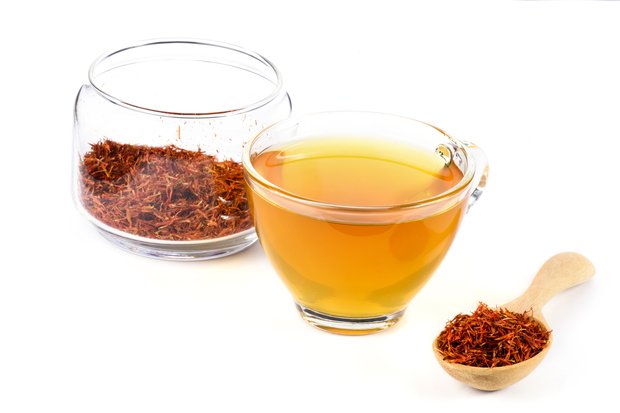
Saffron Tea Benefits
Bioactive constituents in saffron are responsible for its appearance, aroma, and taste. The pigment (crocin) gives it the bright orange color. Picrocrocin is what gives it that bitter bite. The lovely aroma comes from safranal (a volatile compound.) The higher these constituients, the better the saffron is in quality and benefits.
Safranal was found to be effective in treating mild to moderate depression. It was just as effective as the antidepressant fluoxetine. Saffron also helps to reduce gastric ulcers. Second-degree burns healed quicker because of saffron.
Saffron (as mentioned in “Traditional and Modern Uses of Saffron (Crocus sativus)”) is an antioxidant, anti-inflammatory, immune booster, promotes a healthy central nervous system, and contributes to overall skin health. The constituents in saffron decrease the effects of aging and related conditions that come as we grow older.
The Studies In Natural Products Chemistry outlines saffron’s pharmacological benefits include:
- Antitussive
- Reduces risk of Parkinson’s Disease and Alzheimer’s
- Anticonvulsant
- Antipruritic
- Emollient
- Anti-inflammatory
- Cardiovascular health
- Antidiabetic
- Reduces respiratory disorders
- Eye health
- Regulation of menses
How To Make Saffron Tea
We want to harness the beautiful color, benefits, and slight bitterness that saffron provides. Our tea recipe will give you the sassiest cup of tea you’ve ever had! If you are concerned about how much saffron to use in tea, don’t worry, we have that covered.
Hot & Sassy Spiced Saffron Tea Recipe
Ingredients
- 2 cups of water
- 1 teaspoon of loose-leaf rooibos
- 3-6 stigmas of authentic loose saffron
- ¼ teaspoon of ground cinnamon
- ¼ teaspoon of ground cloves
- ¼ teaspoon of ground nutmeg
- ⅛ teaspoon of ground black pepper
- ½ teaspoon of honey
Directions
- Heat the water to 185 degrees (F) (85 degrees C)
- Remove from the heat.
- Place the loose-leaf rooibos into a tea infuser.
- Pour the hot water into a teapot.
- Add the saffron, ground cinnamon, cloves, nutmeg, and black pepper to the teapot.
- Drop the tea infuser into the teapot.
- Cover and allow the tea to steep for 2 minutes.
- Remove the cover.
- Pour the tea into a teacup.
- Add the honey to sweeten.
- Enjoy!
Tips On Using Saffron
- When handling loose saffron, be sure to have dry hands free from residual soap, lotions, or moisture. Saffron is so delicate and dry that it will easily stick to your hands.
- Be careful not to over steep the saffron tea. Too long of a steep will cause it to be very bitter and unpalatable.
- Store the saffron in an opaque, airtight container.
- Place the saffron in a dark, cool pantry or cabinet away from light and humidity.
Saffron Tea Is A “Thumbs Up:” If It’s Authentic
Finding the “real deal” with saffron and avoiding the fake stuff is essential to gain any benefit from a cup of tea made with it. Otherwise, you are faced with nothing more than a cup of adulterated water with who knows what.
